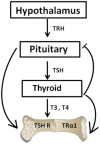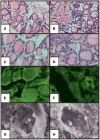Expanding the Role of Thyroid-Stimulating Hormone in Skeletal Physiology
- PMID: 29042858
- PMCID: PMC5632520
- DOI: 10.3389/fendo.2017.00252
Expanding the Role of Thyroid-Stimulating Hormone in Skeletal Physiology
Abstract
The dogma that thyroid-stimulating hormone (TSH) solely regulates the production of thyroid hormone from the thyroid gland has hampered research on its wider physiological roles. The action of pituitary TSH on the skeleton has now been well described; in particular, its action on osteoblasts and osteoclasts. It has also been recently discovered that the bone marrow microenvironment acts as an endocrine circuit with bone marrow-resident macrophages capable of producing a novel TSH-β subunit variant (TSH-βv), which may modulate skeletal physiology. Interestingly, the production of this TSH-βv is positively regulated by T3 accentuating such modulation in the presence of thyroid overactivity. Furthermore, a number of small molecule ligands acting as TSH agonists, which allosterically modulate the TSH receptor have been identified and may have similar modulatory influences on bone cells suggesting therapeutic potential. This review summarizes our current understanding of the role of TSH, TSH-β, TSH-βv, and small molecule agonists in bone physiology.
Keywords: TSH-receptor; TSH-β; TSH-βv; macrophage; osteoblast; osteoclast.
Figures






Similar articles
-
T3 Regulates a Human Macrophage-Derived TSH-β Splice Variant: Implications for Human Bone Biology.Endocrinology. 2016 Sep;157(9):3658-67. doi: 10.1210/en.2015-1974. Epub 2016 Jun 14. Endocrinology. 2016. PMID: 27300765 Free PMC article.
-
Thyroid and bone: macrophage-derived TSH-β splice variant increases murine osteoblastogenesis.Endocrinology. 2013 Dec;154(12):4919-26. doi: 10.1210/en.2012-2234. Epub 2013 Oct 18. Endocrinology. 2013. PMID: 24140716 Free PMC article.
-
Independent Skeletal Actions of Pituitary Hormones.Endocrinol Metab (Seoul). 2022 Oct;37(5):719-731. doi: 10.3803/EnM.2022.1573. Epub 2022 Sep 28. Endocrinol Metab (Seoul). 2022. PMID: 36168775 Free PMC article.
-
TSH and bone loss.Ann N Y Acad Sci. 2006 Apr;1068:309-18. doi: 10.1196/annals.1346.033. Ann N Y Acad Sci. 2006. PMID: 16831931 Review.
-
[Current views of the effects of thyroid hormones and thyroid-stimulating hormone on bone tissue].Probl Endokrinol (Mosk). 2006 Apr 15;52(2):48-54. doi: 10.14341/probl200652248-54. Probl Endokrinol (Mosk). 2006. PMID: 31627621 Review. Russian.
Cited by
-
Lessons from Randomised Clinical Trials for Triiodothyronine Treatment of Hypothyroidism: Have They Achieved Their Objectives?J Thyroid Res. 2018 Jul 16;2018:3239197. doi: 10.1155/2018/3239197. eCollection 2018. J Thyroid Res. 2018. PMID: 30174821 Free PMC article.
-
Skeletal fragility in pituitary disease: how can we predict fracture risk?Pituitary. 2024 Dec;27(6):789-801. doi: 10.1007/s11102-024-01447-3. Epub 2024 Sep 6. Pituitary. 2024. PMID: 39240510 Free PMC article. Review.
-
Effects of Growth-Related Genes on Body Measurement Traits in Wenshang Barred Chickens.J Poult Sci. 2022 Oct 25;59(4):323-327. doi: 10.2141/jpsa.0210138. J Poult Sci. 2022. PMID: 36382061 Free PMC article.
-
The Mysterious Universe of the TSH Receptor.Front Endocrinol (Lausanne). 2022 Jul 12;13:944715. doi: 10.3389/fendo.2022.944715. eCollection 2022. Front Endocrinol (Lausanne). 2022. PMID: 35903283 Free PMC article. Review.
-
Assessment for bone health in patients with differentiated thyroid carcinoma after postoperative thyroid-stimulating hormone suppression therapy: a new fracture risk assessment algorithm.Front Endocrinol (Lausanne). 2023 Nov 21;14:1286947. doi: 10.3389/fendo.2023.1286947. eCollection 2023. Front Endocrinol (Lausanne). 2023. PMID: 38075039 Free PMC article.
References
Publication types
Grants and funding
LinkOut - more resources
Full Text Sources
Other Literature Sources
Research Materials

